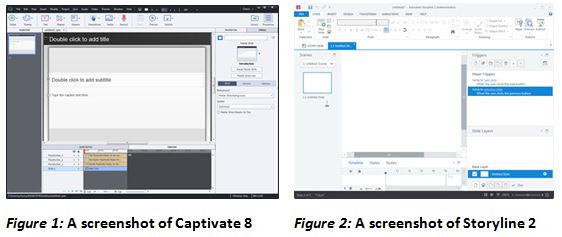In the United States, eLearningaccounts for about one-third of total training hours in corporations. Most ofthe eLearning content is developed with software that is commonly referred toas rapid eLearning development (RED) programs (Mallon, 2011). Currently, AdobeCaptivate and Articulate Storyline are among the most popular RED programs thatallow eLearning developers to build eLearning content quickly and inexpensively(Shank, 2010; Shank, 2013a; Shank, 2013b).
In this article, we present ananalysis of these two RED programs in order to better understand which featuresof the programs novice eLearning developers would likely use and which onesthey would be less likely to use. We also present a case study that weconducted to answer the question, “What components of the rapid eLearningdevelopment programs do novice eLearning developers value, and why?” We believethe results from the study may be useful to eLearning managers and team leadersin guiding the professional development of novice developers.
Background
Unlike the traditional eLearningdevelopment process, rapid eLearning development involves the increased use oftemplates and repurposing of existing content and multimedia elements in orderto reduce the number of developers involved as well as the time and costsrequired. It is purported that the use of RED programs instead of traditionalauthoring programs may help cut down the average time for developing aseat-time learning hour of highly interactive and media-rich eLearning productsfrom 30 – 40 hours to 15 – 20 hours (Ganci, 2011).
Buyers of these RED programsalso expect the learning curve for them to be lower than that of other, moresophisticated, eLearning development solutions. For that reason, RED programsattract unskilled and novice practitioners who want to jump-start their abilityto produce eLearning products. However, becoming an eLearning developer isstill a long journey.
When developing professionalskills, learners go through several stages—for example, five stages such as novice,advanced beginner, competent, proficient, and expert (Dreyfus, 2004; Dreyfus andDreyfus, 1986), or six stages such as unskilled or not relevant, novice,learner, competent, proficient, and expert (Gillies and Howard, 2003). Althoughnot all eLearning developers need to reach the expert level, they would need tobecome competent enough to use the RED programs to design eLearning productswith appropriate instructional design strategies.
Even though the RED programs’ relativelyshort learning curve allows many novice eLearning developers to easily getinvolved in eLearning development, there is a potential risk if they fail tocomply with foundational eLearning design principles, such as the ones thatMayer and others have helped develop based on their research findings (Clark,2002; Mayer, 2003). These eLearning design principles are:
- Themultimedia principle: Adding graphics to words can improve learning
- Thecontiguity principle: Placing text near graphics improves learning
- Themodality principle: Explaining graphics with audio improves learning
- Theredundancy principle: Explaining graphics with audio and redundant text canhurt learning
- Thecoherence principle: Using gratuitous visuals, text, and sounds can hurtlearning
- Thepersonalization principle: Use conversational tone and pedagogical agentsto increase learning
It is also important that eLearningdevelopers understand how to design eLearning products to help learners handledifferent types of cognitive load (Nguyen and Clark, 2005):
- Manage intrinsiccognitive load (mental capacity required to handle the complexity of thecontent)
- Maximize germaneload (mental capacity supported by relevant learning activities such asexamples and practices)
- Minimize extraneousload (mental capacity disrupted by irrelevant information)
Other tips for designing eLearningproducts include: not designing slides that look like PowerPoint slides; notpresenting a wall of text on the screen; and not designing them so as to makelearners completely passive (Shank, 2011).
For those reasons, educationaland training programs should focus on teaching novice eLearning developers notonly the technical skills of how to use certain features of eLearningdevelopment software programs but also how to design eLearning products basedon valid eLearning design principles. In our educational institution, we offer severaleLearning design and development courses for our Workplace eLearning and PerformanceSupport certificate program. Most of our students who take the eLearningcourses are novice eLearning developers who have not developed eLearningproducts using RED programs. They tend to enroll in the eLearning courses withhigh levels of excitement about acquiring eLearning development skills.However, their actual experience of learning to use RED programs may differfrom their expectations. To better understand novice eLearning developers’experiences of learning to use RED software programs, we conducted a case studyin our eLearning classes in which students were required to use Adobe Captivateand Articulate Storyline to develop eLearning products.
Acomponent analysis of the RED programs
RED software programs offercommon and unique features through a menu-driven user interface. Users develop eLearningproducts by selecting menu items within a what-you-see-is-what-you-get(WYSIWYG) interface, without having to perform any sophisticated programming orcoding. By treating those menu items as the main components of RED programs, we first conducted a component analysisof the two RED programs, Adobe Captivate 8 and Articulate Storyline 2 (seeFigure 1 and Figure 2). (Editor’s Note: Anumber of Adobe Captivate features have changed, including the addition of newcomponents, with the release of Adobe Captivate 9 in September, 2015.)

During our component analysisof the two RED programs, we listed all main components available in eachprogram, identified components that are common in both programs, and identifiedcomponents that are unique to each program. During that process, we realizedthat it would make more sense to list the components of the RED programs on acontinuum from the far left end of “Almost the same” to the far right end of“Unique” with “Common but different” in the middle, as Figure 3 shows.

Figure 3: Similarity anduniqueness of the two RED programs’ components on a continuum
For example, the two REDprograms provide very similar approaches to slide transitions, timelinecontrols, themes, interactive templates and objects, previews, audio, andobject animation. One of the most attractive of these similar features fornovice rapid eLearning developers is the Import function. It allows users toimport existing PowerPoint slides, as well as several pre-configured templatesincluding interactive tabs, drag-and-drop, and an assortment of quiz designs.
Also, the “look and feel” ofthe player skin is fairly consistent between the two RED programs. Theseinclude standard settings for navigation, player controls, table of contents,color and text themes, and bookmarking. However, Storyline alsooffers an optional Course Resources and Glossary folder tab that can addvaluable extensions to programs that are heavy in content. Captivate 8, incontrast, offers a unique toggle view-or-hide control of the table of contents duringrun-time mode. This feature can help optimize the viewing real estatefor course content within the browser.
Characters,also known as pedagogical agents, offer a good opportunity to apply thepersonalization principle (Mayer, 2003), especiallywhen combined with a conversational type of narrative. Characters workparticularly well for soft-skills or scenario-based eLearning courses. Both Captivate8 and Storyline have a selection of illustrated and photographic characterswith a variety of poses. There are pros and cons in each program’s character’sfunction. Captivate has different categories of photographic characters(business, casual, and medicine) with a variety of poses. Storyline comes withonly one photographic character and many illustrated characters, and it convenientlyallows users to change a character’s pose or perspective by using triggers; thisfunctionality is not available in Captivate.
Storyline’s Layers as well asTriggers are probably among the most distinguishing features. Layerscan display additional content on a given slide at specified intervals or inresponse to learners’ actions. The use of layers allows you to break down amore complex sequence of actions and events into workable steps and string theaction together using triggers.
An equally unique featurewithin Captivate is the text-to-speech feature. In a matter of a few clicks, Captivateallows you to convert slide notes into closed-captioned text, or into audiofiles using text-to-speech software from NeoSpeech.This add-on software provides several differentvoices to choose from. Other unique features within Captivate 8 that are worthexploring include its responsive design for adaptability to different deliverydevices, Aggregator Project, and Multi-SCORM Packager features.
This component analysis helpedus understand which features of the programs novice eLearning developers would likelyuse and which ones they would not be likely to explore and use in their eLearningproducts in less than ten weeks of learning in a three-credit course. Our eLearningcourse did not have planned course activities that introduced students to someof the intermediate and advanced features of the programs such as Multi-SCORMPackager or SCORM output settings. Although it is possible that somestudents explored those intermediate and advanced features of the programs ontheir own, it is unlikely that they became competent to use those additional featureswithin the short timeframe, while following planned course objectives andrequirements.
A case studywith a user-value analysis of the RED programs
Weused a convenient sample of novice eLearning developers who enrolled in a graduate-levelrapid eLearning development class at a mid-size university in the northwesternregion of the United States during spring and summer of 2014 and 2015. Among thetotal of 54 students who enrolled in the class during the four semesters, 31students (57 percent) voluntarily participated in the study. The main questionthat we addressed during this study was: Whatcomponents of the rapid eLearning development programs do novice eLearningdevelopers value, and why?
Data collection
The rapid eLearning developmentclass was a ten-week online class, where students were required to useCaptivate 8 and Storyline 2 to complete four eLearning products as their classprojects. Students were assigned to develop different types of eLearningproducts—declarative, procedural, and situated (Chyung, 2007). Declarativeknowledge (knowing what) is often included in introductory content andorientation training. Procedural knowledge (knowing how) is often demonstratedin software and other technical training. Situated knowledge (knowing when andwhy) is often developed through scenario-based learning. Students developedtheir eLearning products with five to 15 minutes of seat-time learning. Studentslearned not only technical skills on how to use the RED programs, but also eLearningand design principles and guidelines (see Clark, 2002; Mayer, 2003; Nguyen andClark, 2005; Shank, 2011).
At the end of the course, wecollected data from the students using an anonymous user-value analysis survey.This 20-item survey measured users’ demographic information and theirperceptions about the overall quality of the RED programs. The survey alsomeasured the values of several specific components of the programs that arelikely used by novice eLearning developers, and how well those componentssupported the instructional design strategies that they would incorporate intheir eLearning products.
The average age of the surveyrespondents was 41 years old (ranging between 26 and 59). Most respondents heldfull-time job titles such as instructional designers, content developers, ortraining managers, in various industries. About half (51 percent) of therespondents have had instructional design as part of their job responsibilitiesfor more than five years, while 33 percent have had those responsibilities for oneto five years, respectively. Even though their current job responsibilitiesincluded instructional design or similar roles, most of them reported havinglimited experience in eLearning development. On a five-point scale (novice,advanced beginner, competent, proficient, and expert) that measures theircurrent eLearning development, 64 percent of respondents characterizedthemselves as novices or advanced beginner in terms of their current eLearningdevelopment skills. Two-thirds of the respondents had never used Captivate orStoryline before they took the class (60 percent and 74 percent, respectively).This put them in the “novice eLearning developers” category. They indicatedthat it was very important to learn eLearning skills (mean = 4.7 on a five-pointscale, where one is not important at all and five is very important). Thedominant reason for acquiring eLearning skills was for their careerdevelopment.
Findings
Overall, the novice eLearningdevelopers who participated in the study rated Storyline more favorably thanCaptivate. Paired-sample t-tests on the mean differences showed that they ratedsome aspects of Storyline significantly higher than those of Captivate. Thatis,
- How quickly they can learn to use it: Mean (Captivate)= 3.35, Mean (Storyline) = 4.29, t(30) = -4.76, p < .001.
- How user-friendly the interface is: Mean (Captivate)= 3.29, Mean (Storyline) = 4.48, t(30) = -5.84, p < .001.
- How quickly they can develop a product with it:Mean (Captivate) = 3.45, Mean (Storyline) = 4.25, t (30) = -4.29, p <.001.
- How useful the menu items and other featuresare: Mean (Captivate) = 3.58, Mean (Storyline) = 4.32, t (30) = -3.20, p = .003.
- How well it helps them incorporate theirinstructional strategies: Mean (Captivate) = 3.70, Mean (Storyline) = 4.19, t (30) = -2.80, p = .009.
- How the final products look: Mean (Captivate) =3.87, Mean (Storyline) = 4.38, t (30)=
-2.49, p = .018.
The most useful features ofCaptivate that the novice eLearning developers frequently mentioned were: text-to-speech,closed captioning, and software simulation, whereas the most useful features ofStoryline reported were layers, triggers, characters, and branching view. Thenovice eLearning developers were asked whether they could perform several eLearningdevelopment tasks better with Captivate or Storyline. Their assessments are summarizedbelow and shown in Figure 4.
Captivate is better when:
- Adding closed captions (related to theredundancy principle and to comply with Section 508)
- Adding audio narration to slides (for themodality principle)—e.g., using the text-to-speech feature
- Developing simulated software training products(related to the multimedia principle)
Captivate and Storyline are similar when:
- Adding text next to graphics during simulatedsoftware training (related to the contiguity principle)
- Developing slides that do not look likePowerPoint slides
- Aligning time sequence of objects (text, images,buttons, etc.) using the timeline
- Developing knowledge questions
- Publishing eLearning products
Storylineis better when:
- Adding images to slides (related to themultimedia principle)
- Formatting text (e.g., changing font type, size,color, line spacing, etc.)
- Adding characters to slides (related to thepersonalization principle)—i.e., availability of various poses

Figure 4: User evaluation onseveral features of the two RED programs
The novice eLearning developerssaid that they felt motivated to learn to use Captivate and Storyline for thefollowing reasons and context:
- Because the programs allow them to developinteractive eLearning products and help them advance their career
- Because they see the skills necessary for theircurrent or future career development
- When they are provided clear directions on howto develop such eLearning products
- When they review eLearning samples that theywant to develop
However, some of the thingsthat demotivated them while using Captivate included:
- Their organization does not support Captivate
- Only a few tutorials are freely available on theweb (especially, lack of video-based tutorials)
- There is a steep learning curve (e.g., gettingused to its user-interface) compared to Storyline
Some of the things thatdemotivated them while using Storyline included:
- Their organization does not support Storyline
- Its cost was high
- A Mac version is not readily available
Understandably, the novice eLearningdevelopers also indicated that they felt overwhelmed by the many featuresprovided in both software programs.
The most frequently mentionedinstructional strategies they wanted to incorporate in their eLearning productswere simulated software training, scenario-based learning, knowledge quizzes,and interactive practice activities. We categorize these types of eLearningproducts as fairly interactive and media-rich. To develop these instructionalstrategies, about two-thirds of the novice eLearning developers (62 percent)said they would prefer using Storyline and the most common reason for theirdecision was its user-friendliness and ease of use. The remaining one-third ofthem who said they would prefer using Captivate indicated the following reasonsfor selecting Captivate: its easy-to-use feature for developing simulatedsoftware training products, its unique features such as text-to-speech, itscompatibility for both Windows and Mac systems, and its advanced features suchas variables and libraries.
Discussions
Organizations adopt rapid eLearningdevelopment tools to keep up with their business needs; for example, fastdevelopment and deployment of training programs to update the knowledge andskills of their workforce (Mallon, 2011). Today’s employers expect theirinstructional designers to possess competencies other than ID-specific skills,including abilities to develop eLearning solutions using authoring programs(Munzenmaier, 2014). Most survey respondents in our study were instructionaldesigners who decided to learn about eLearning development for that veryreason, and evidence from this study suggests that novice eLearning developerswould likely benefit to start their journey of eLearning development with REDprograms such as Captivate and Storyline, rather than more sophisticated softwareprograms.
The types of content that aremost frequently developed by using RED programs include: Introductory content,testing and assessment, compliance and mandatory training, software and applicationtraining, product demonstrations, orientation training, and technical training(Mallon, 2011), which seem to fall into the declarative and procedural types ofknowledge.
Software users would likelyevaluate the worth of the software products based on the degrees of power andease-of-use of the products compared against the users’ own needs and costs ofthe products. For example, Figure 5 illustrates two hypothetical examples ofsoftware programs (Product #1 and Product #2) with different levels of power,ease-of-use, cost, and user needs. Product# 1 (indicated with solid lines) has higherpower but also higher cost and lower ease-of use than Product #2 (indicatedwith dotted lines). If users do not need to use all of the powerful featuresthat Product #1 provides, they may use the ease-of-use factor (internal) and/orthe cost factor (external if they purchase it or external if their organizationpurchases it for them), and Product #2 may look more favorable to them. However,a caveat here is that novice eLearning developers may not be able to accuratelyassess the power of each RED program, and their assessment would heavily relyon the ease-of-use criterion when the users’ needs can be satisfied with eitherproduct. This may be the reason why most of the survey respondents in our studyexpressed their preference of Storyline to Captivate, but were frustrated thattheir organizations have not decided to purchase Storyline.

Figure 5: A set of softwareselection criteria
Also, although RED programs ingeneral are viewed as easy to use, Captivate is not considered to be theeasiest one to use. Ganci (2011) estimates that on a 10-point scale where 1 =hardest and 10 = easiest, Captivate’s power level is 7 and its ease-of-uselevel is 5, whereas Articulate Presenter and Camtasia Studio have a power levelof 5 but an ease-of-use level of 8 or 7. Our survey data seems to support thisnotion; the novice eLearning developers expressed that given a choice, theywould choose to use Storyline over Captive for its ease-of-use.
However, asking novice eLearningdevelopers to choose one option does not help paint the whole picture of eLearningdevelopment. eLearning developers usually use more than one RED program, andthis trend increases as the eLearning developers’ experience increases (Ganci,2011). Thus novice eLearning developers may start with one RED program, but addmore RED programs to their toolbox as time goes by and their eLearningdevelopment skills improve. Subsequently, the eLearning developers’ andorganizations’ needs may increase as well. In the beginning, novice eLearningdevelopers may be thinking about developing simpler declarative and proceduraltypes of content. Then, as they develop more skills, they may venture to developtheir products with more sophisticated scenario-based branching techniques andhighly interactive and media-rich content. Thus, they may seek products like Figure5’s Product #1.
Our case study demonstrates aconvenience sample of novice eLearning developers’ perceptions and preferencetoward two RED programs based on a relatively short time of usage. The knowledgegenerated from this study may help understand what features of RED programsnovice eLearning users tend to pay attention to and what factors influence theirpreference and value judgement. However, it should not be used to drawconclusions regarding the quality of the different RED programs or the level ofpopularity between these two RED programs in the industry.
References
Chyung, S. Y. “Learning Object-based eLearning: Content Design, Methods, and Tools.” LearningSolutions Magazine. 27 August 2007.
Clark, R. “Six Principles of Effective eLearning: What Works and Why.” Learning Solutions Magazine. 10September 2002.
Dreyfus, S. “The Five-stage Model of AdultSkill Acquisition.” Bulletin of Science,Technology & Society, 24(3). 2004.
Ganci, J. Rapid eLearning Authoring: Top Tools.The eLearning Guild. 2011.
Gillies, A., and J. Howard. “Managing Changein Process and People: Combining a Maturity Model with a Competency-based Approach.”TQM & Business Excellence, 14(7).2003.
Mallon, D. Comparing Adoption of Rapid eLearning Development Tools by Key U.S. Industries.Bersin & Associates Research Report. 2011. Downloaded from: https://www.adobe.com/content/dam/Adobe/en/products/framemaker/whitepapers/bersin_adobe_rapide_learn_adoption_dm.pdf
Mayer, R. E. “The Promise of MultimediaLearning: Using the Same Instructional Design Methods Across Different Media.” Learning and Instruction, 13(2). 2003.
Munzenmaier, C. Today’s Instructional Designer: Competencies and Careers. The eLearning Guild. 2014.
Nguyen, F., and R. C. Clark. “Efficiency in eLearning: Proven Instructional Methods for Faster, Better, Online Learning.”Learning Solutions Magazine. 7November 2005.
Shank, P. Getting Started in eLearning: Rapid eLearning.The eLearning Guild. 2010.
Shank, P. “Beginning Instructional Authoring: Decide What to Leave Out.” Learning Solutions Magazine. 10 February 2011.
Shank, P. eLearning Authoring Tools 2013: What We’re Using, What We Want. The eLearning Guild. 2013a.
Shank, P. Learning Technologies 2013: Where We Are Now. The eLearning Guild. 2013b.








